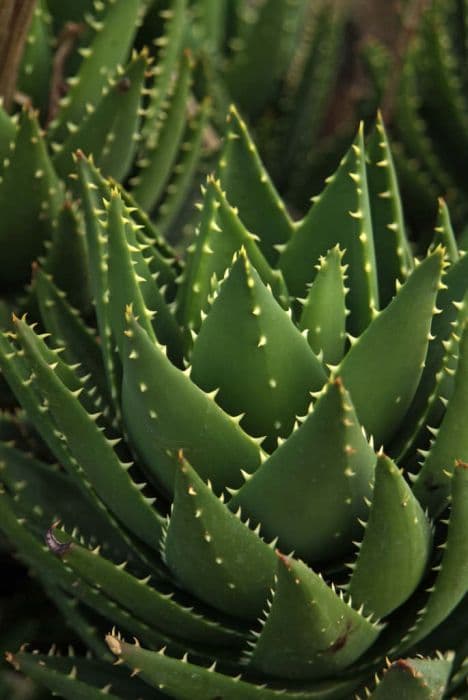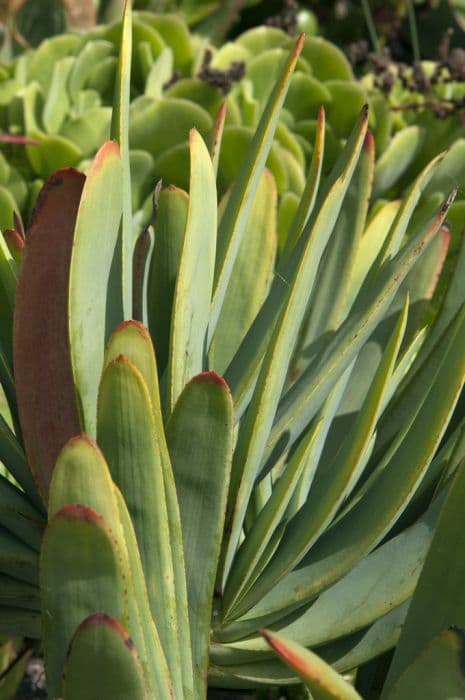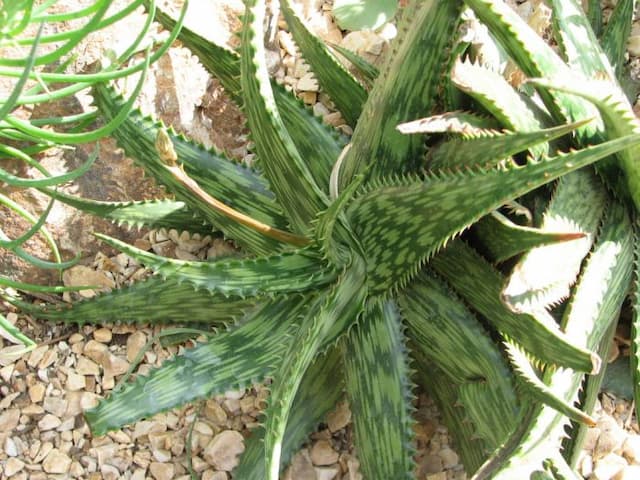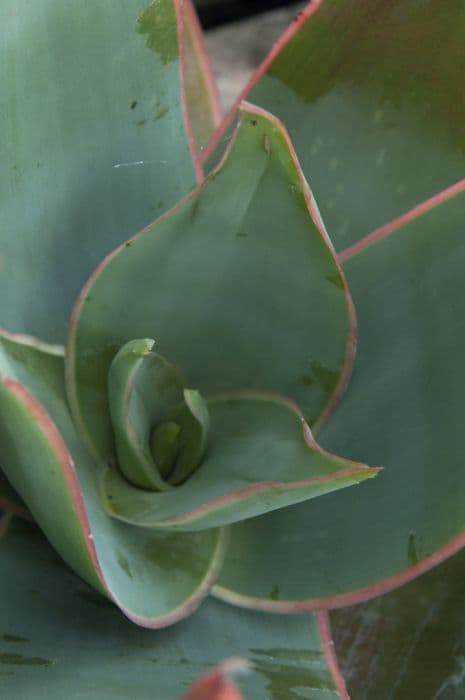Summer Asphodel Asphodelus aestivus

ABOUT
Asphodelus aestivus, commonly known as summer asphodel, is a perennial plant that is characterized by its striking and picturesque appearance. It features a clumping growth habit, with a dense rosette of long, slender, and arching leaves. The leaves are typically grey-green with a slight succulent texture, giving them a robust and hardy look. During the blooming season, the summer asphodel produces tall, erect flower spikes that are adorned with numerous small, star-shaped flowers. These flowers are typically white with a hint of green or brown on the outside and are marked by a central stripe that can be yellow or brown, creating a captivating contrast against the pale petals. The overall impression of the summer asphodel is graceful yet sturdy, with its showy bloom spikes providing an impressive visual display in the landscape where it is found.
About this plant
 Names
NamesFamily
Asphodelaceae.
Synonyms
Summer Asphodel, Common Asphodel, King's Spear, Asphodel.
Common names
Asphodelus microcarpus, Asphodelus ramosus subsp. microcarpus.
 Toxicity
ToxicityTo humans
Common Asphodel (Asphodelus aestivus) is not widely known for being toxic to humans. There is limited information on the plant's toxicity as it is not commonly ingested. However, as with any plant, individual allergies or sensitivities can occur. It is always advisable to exercise caution and avoid eating or handling plants unless you are certain they are safe and you are not allergic to them.
To pets
Common Asphodel (Asphodelus aestivus) also does not have a well-documented history of toxicity in pets. While there is little specific information on this plant's effects on domestic animals, it is generally recommended to prevent pets from ingesting plants that are not known to be safe. If a pet does ingest this plant, monitor for any signs of illness and consult a veterinarian if any adverse reactions are observed.
 Characteristics
CharacteristicsLife cycle
Perennials
Foliage type
Deciduous
Color of leaves
Green
Flower color
White
Height
2 feet (60 cm)
Spread
1 foot (30 cm)
Plant type
Herb
Hardiness zones
8
Native area
Mediterranean
Benefits
 General Benefits
General Benefits- Ecological Support: Asphodelus aestivus, commonly known as summer asphodel, provides habitat and food for a variety of wildlife, including insects and birds.
- Soil Improvement: The summer asphodel's root system can help prevent soil erosion and improve soil structure.
- Drought Resistance: Being a Mediterranean plant, it is highly drought-resistant, making it an excellent choice for xeriscaping and arid environments.
- Landscape Aesthetics: With its tall flowering spikes and attractive foliage, summer asphodel can contribute to the visual appeal of natural landscapes and gardens.
- Cultural Significance: Summer asphodel has historical and mythological significance, particularly in Greek culture, where it was associated with the Elysian Fields and the dead.
- Educational Value: The plant can be used for educational purposes, teaching about Mediterranean ecosystems and plant adaptability.
- Low Maintenance: It requires minimal care once established, making it a good option for low-maintenance gardening practices.
 Medical Properties
Medical Properties- Anti-inflammatory: Asphodelus aestivus has been used to reduce inflammation.
- Diuretic: The plant has been reported to have diuretic properties, which can help in the increased production of urine.
- Demulcent: It is believed to have demulcent qualities, soothing irritated or inflamed tissue.
- Laxative: Asphodelus aestivus may possess mild laxative effects.
- Antimicrobial: There are indications that it has antimicrobial activities against certain types of bacteria.
 Air-purifying Qualities
Air-purifying QualitiesThis plant is not specifically known for air purifying qualities.
 Other Uses
Other Uses- Asphodelus aestivus, commonly known as summer asphodel, has been used historically to make a glue-like substance when its roots are boiled down.
- In rural traditions, the fibrous part of the summer asphodel's leaves was sometimes used for making durable strings and threads.
- The seeds of the summer asphodel can be ground into a rudimentary flour, although it is not a commonly used food source.
- The summer asphodel's thick roots can be used to craft small utensils or tools after proper treatment and carving.
- The stalk of the summer asphodel can serve as a natural support stake for other plants in gardening due to its stiffness.
- Dried stems of the summer asphodel have historically been used as fire starters due to their flammability when dry.
- In some folk practices, dried summer asphodel flowers are used as decoration in homes or woven into wreaths.
- The summer asphodel's leaves may be used in a type of primitive papermaking process.
- Summer asphodel has been used occasionally as a natural dye for fabrics, giving a yellowish hue.
- Cattle and sheep grazing areas sometimes use the presence of summer asphodel plants to gauge the quality of pasture land, as it is an indicator of overgrazing and poor soil conditions.
Interesting Facts
 Feng Shui
Feng ShuiThe Asphodel is not used in Feng Shui practice.
 Zodiac Sign Compitability
Zodiac Sign CompitabilityThe Asphodel is not used in astrology practice.
 Plant Symbolism
Plant Symbolism- Afterlife: In Ancient Greek mythology, asphodels were associated with the Elysian Fields, the final resting place of the souls of the heroic and the virtuous. The Asphodelus aestivus, known commonly as the common asphodel, was believed to cover these meadows, symbolizing death and the afterlife.
- Remembrance: Due to its connection with the dead, the common asphodel is often seen as a symbol of remembrance for lost loved ones, reflecting the flower's presence in funerary rites and its growth on graves.
- Mourning: The asphodel's link to death also makes it a symbol of mourning, representing the sorrow and grief felt at the loss of life.
- Regeneration: Despite its associations with death, asphodels bloom anew each year, representing regeneration and the eternal cycle of life, death, and rebirth.
 Water
WaterCommonly known as summer asphodel, Asphodelus aestivus should be watered deeply but infrequently to mimic its natural Mediterranean habitat. Established plants prefer dry conditions and will only require additional water during prolonged dry spells, typically not more than once every two to three weeks. When watering, aim for about one to two gallons per plant, ensuring that the water penetrates deeply into the soil to encourage robust root growth. Overwatering can lead to root rot, so let the soil dry out completely between watering sessions.
 Light
LightSummer asphodel thrives in full sunlight, appreciating at least six to eight hours of direct sun daily. Planting it in a south-facing location ensures that it receives ample sunlight to promote healthy growth and abundant flowering. Avoid shaded areas, as insufficient light can lead to weak growth and fewer blooms.
 Temperature
TemperatureThe summer asphodel is tolerant of a wide range of temperatures, surviving in conditions as low as 20°F and as high as 90°F or more. However, the ideal temperature for thriving summer asphodel is between 60°F and 75°F. It is frost-hardy and can withstand cooler nights, but extreme cold or heat for prolonged periods may be detrimental.
 Pruning
PruningPruning summer asphodel is mostly to remove spent flower stalks and any damaged or dead foliage, which encourages a tidy appearance and may promote new growth. This should be done after flowering, usually in the late summer or early fall. Occasional thinning of crowded clumps can be done every few years to rejuvenate the plant and maintain its vigor.
 Cleaning
CleaningAs needed
 Soil
SoilSummer Asphodel thrives best in well-draining soil with a pH level between 6.0 and 7.5. A mix of one part sand, one part garden soil, and one part compost or peat moss would be ideal to ensure proper drainage while providing essential nutrients.
 Repotting
RepottingSummer Asphodel should be repotted every two to three years to ensure it has enough space to grow. This plant does not have a high requirement for frequent repotting.
 Humidity & Misting
Humidity & MistingSummer Asphodel prefers a dry to moderate humidity environment and is quite drought-tolerant. High humidity levels are not necessary for this plant's growth.
 Suitable locations
Suitable locationsIndoor
Ensure full sun, well-draining soil, and infrequent watering for Summer Asphodel.
Outdoor
Plant in full sun, in well-draining soil; water sparingly for Summer Asphodel.
Hardiness zone
7-11 USDA
 Life cycle
Life cycleAsphodelus aestivus, commonly known as the summer asphodel, begins its life cycle as a seed, which germinates when conditions of moisture and temperature are favorable, typically in the fall or early spring. After germination, the seedling emerges and develops a rosette of narrow, linear leaves at the ground level, undergoing vegetative growth. As the plant matures, it elongates a flowering stalk from the center of the rosette during late spring to summer, producing white to pale pink flowers with a central brown or reddish stripe. Following pollination, which is often facilitated by bees and other insects, the flowers produce capsule-like fruits that contain numerous seeds. These seeds are dispersed by various means, including wind and animals, ensuring the spread of the plant to suitable new locations. Finally, the plant enters a period of dormancy during the late summer to early autumn, especially in regions with hot, dry climates; the above-ground parts may die back, but the plant can regenerate from its underground tuberous root system in the next season.
 Propogation
PropogationPropogation time
Spring to Summer
The most popular method of propagation for Asphodelus aestivus, commonly known as summer asphodel, is by seed. The best time to sow seeds is in autumn so they can benefit from the cooler temperatures during germination. To propagate by seed, one would scatter the seeds lightly over a well-draining potting mix, covering them with a thin layer of soil. It's crucial to keep the soil moist but not waterlogged. Seedlings usually emerge within a few weeks, depending on the environmental conditions. After the seedlings have grown sufficiently and are sturdy enough to handle, they can be transplanted into individual pots or directly into the garden, maintaining a distance of about 12 inches (approximately 30 centimeters) apart to allow room for growth.









